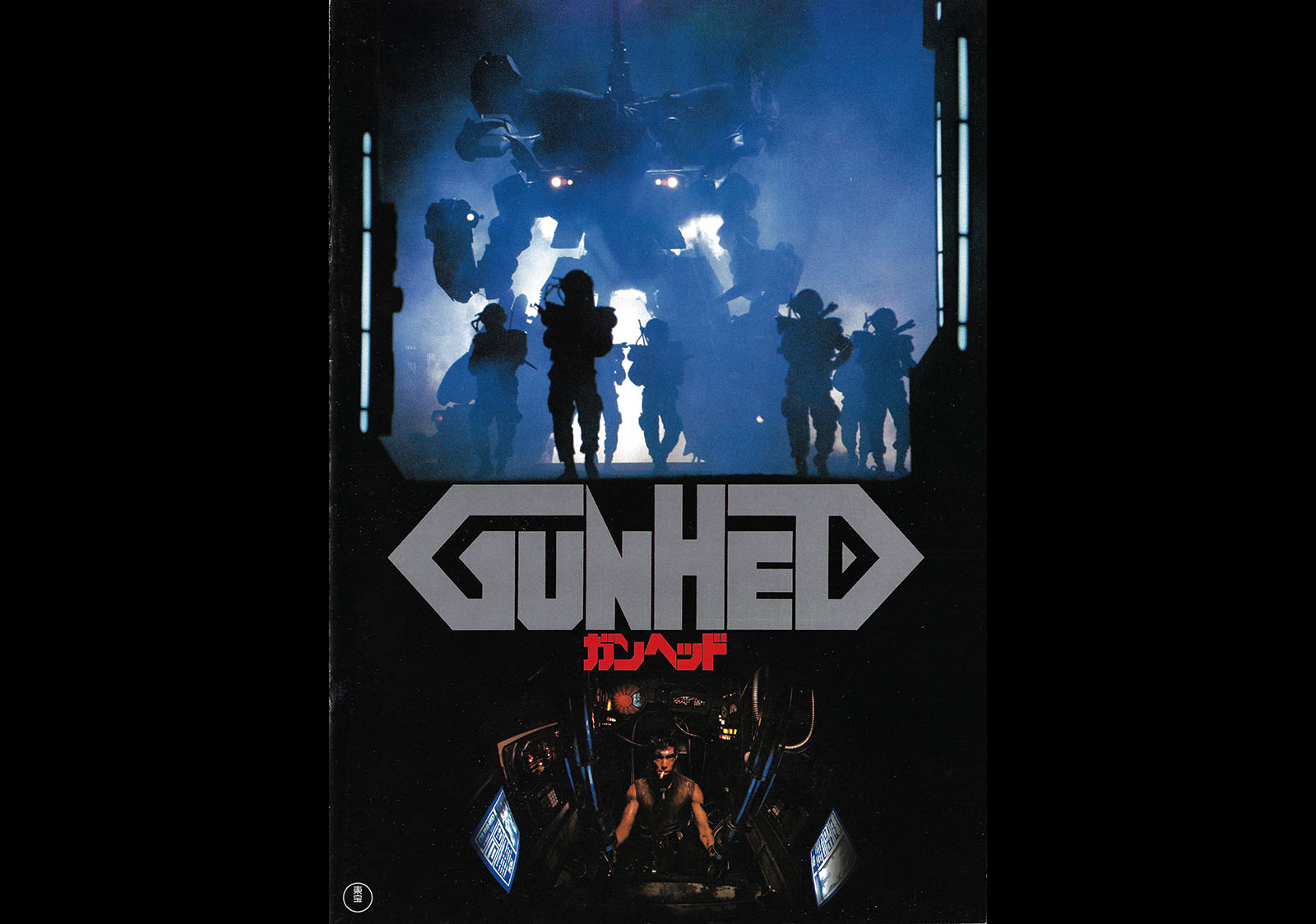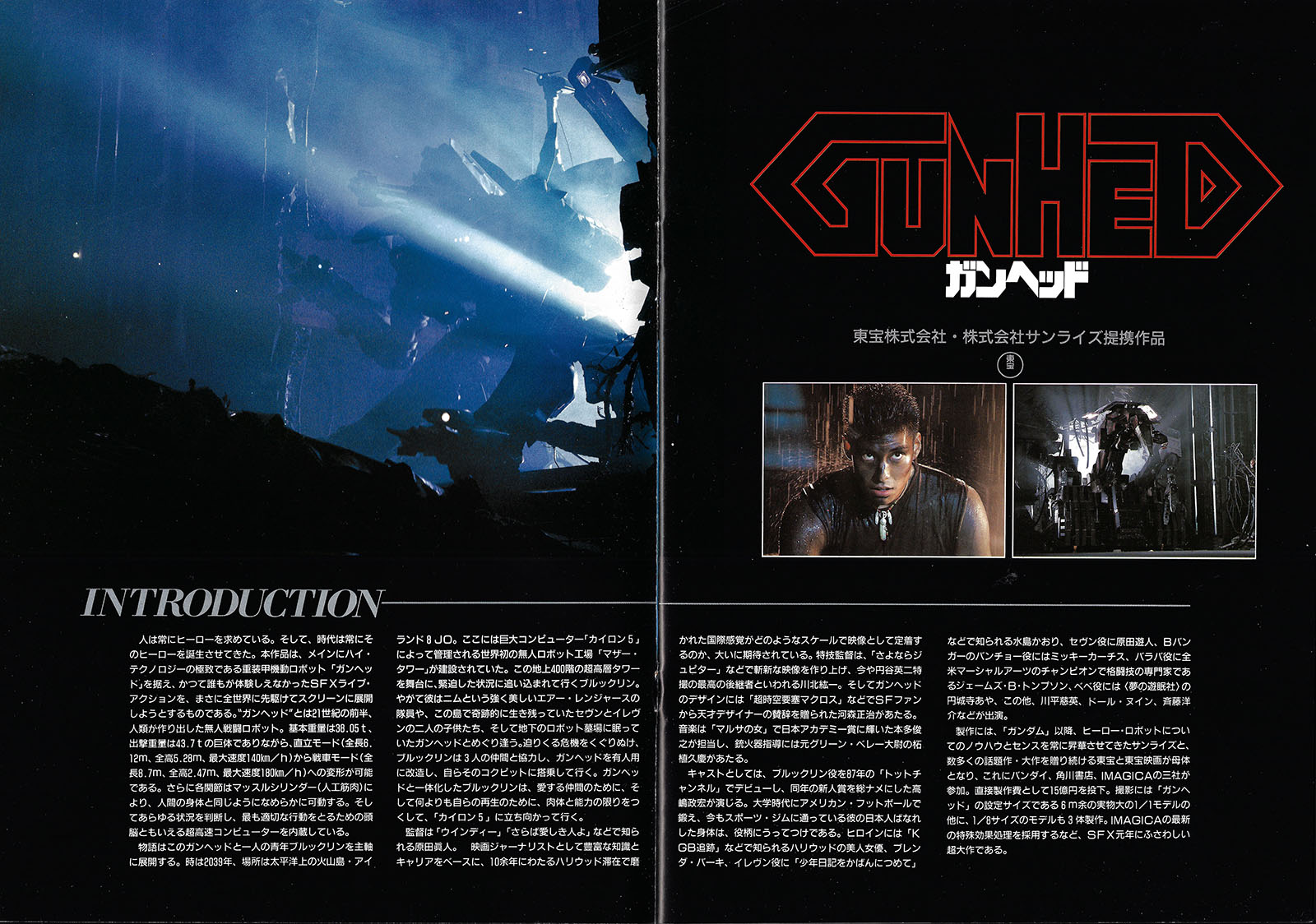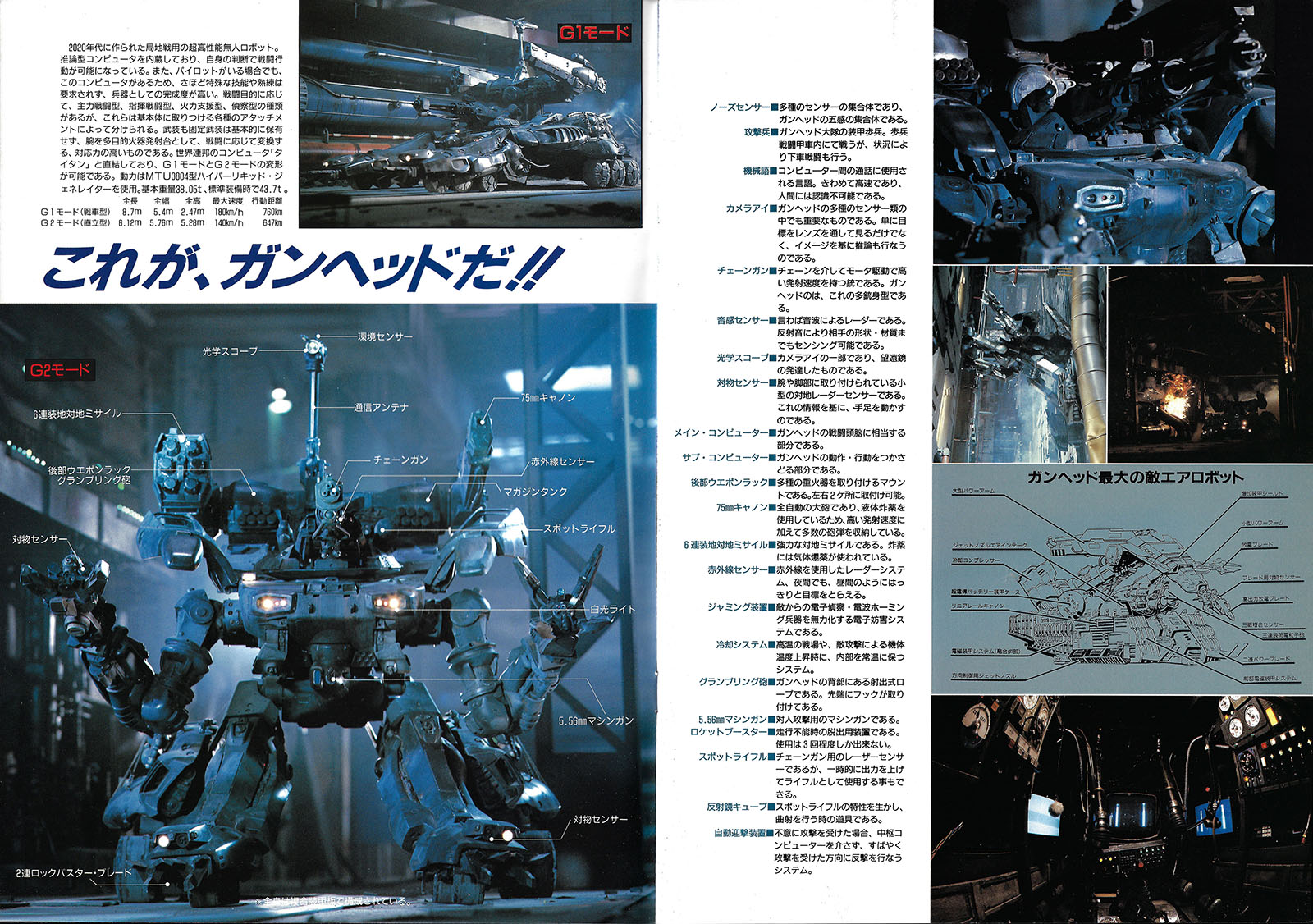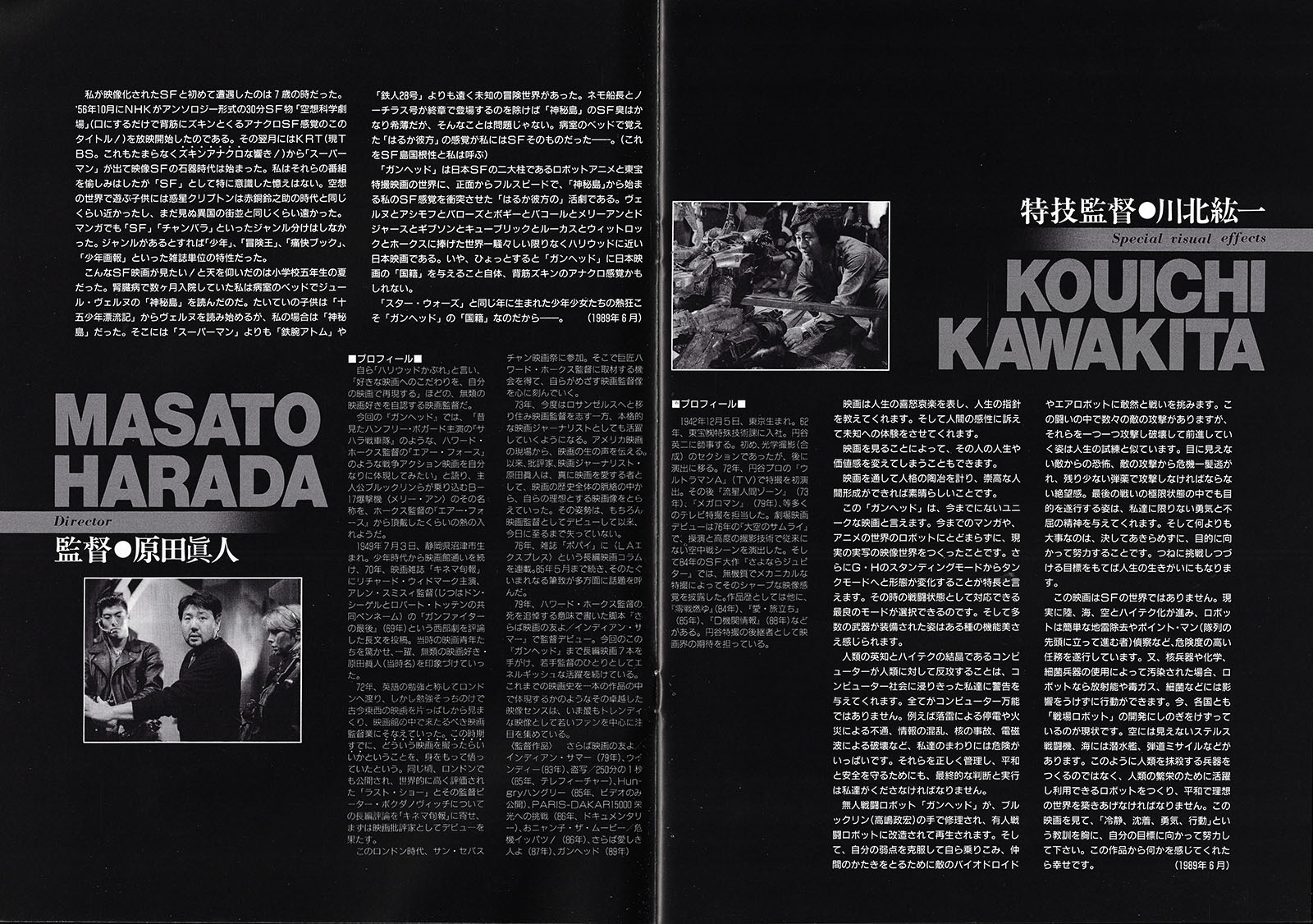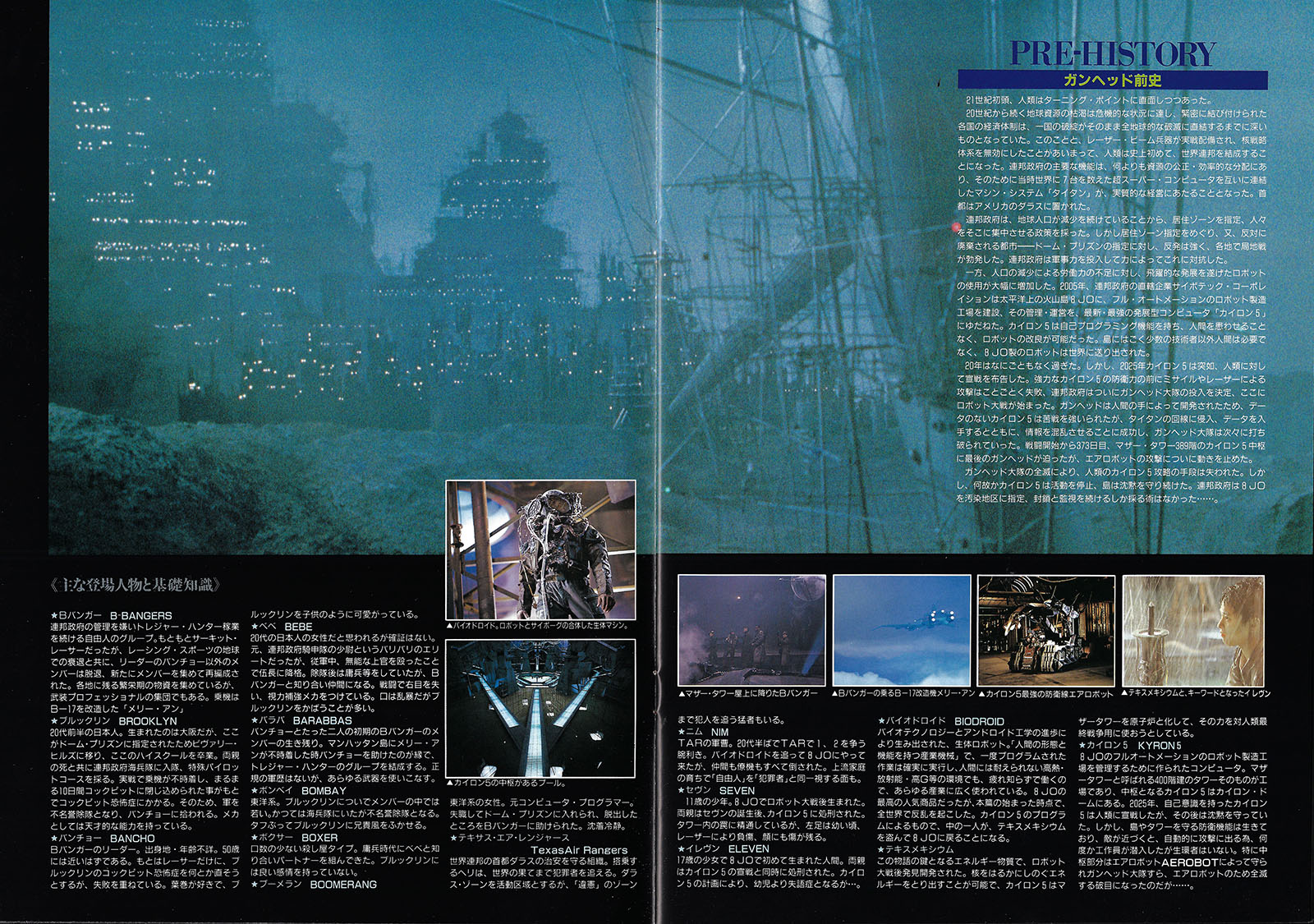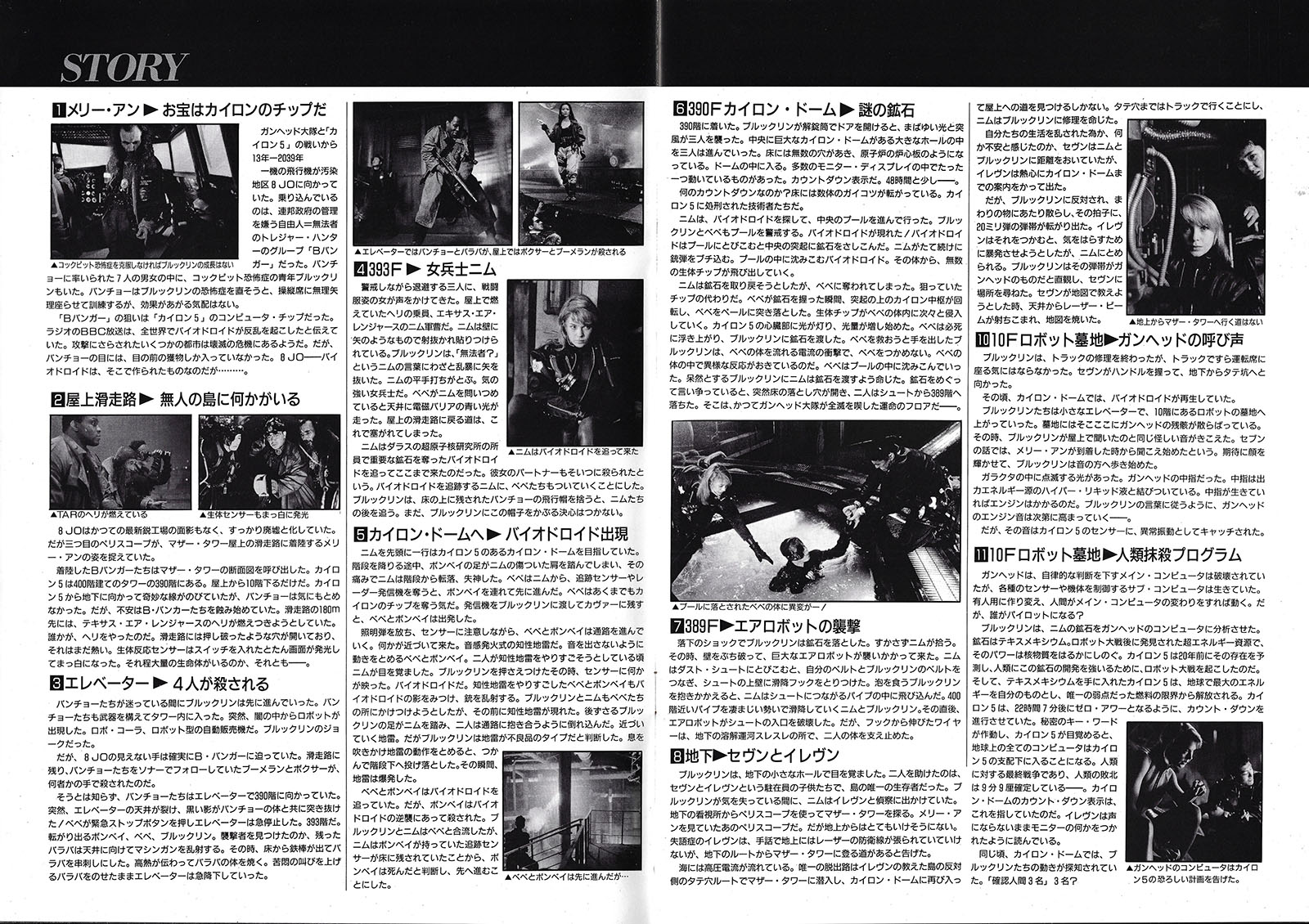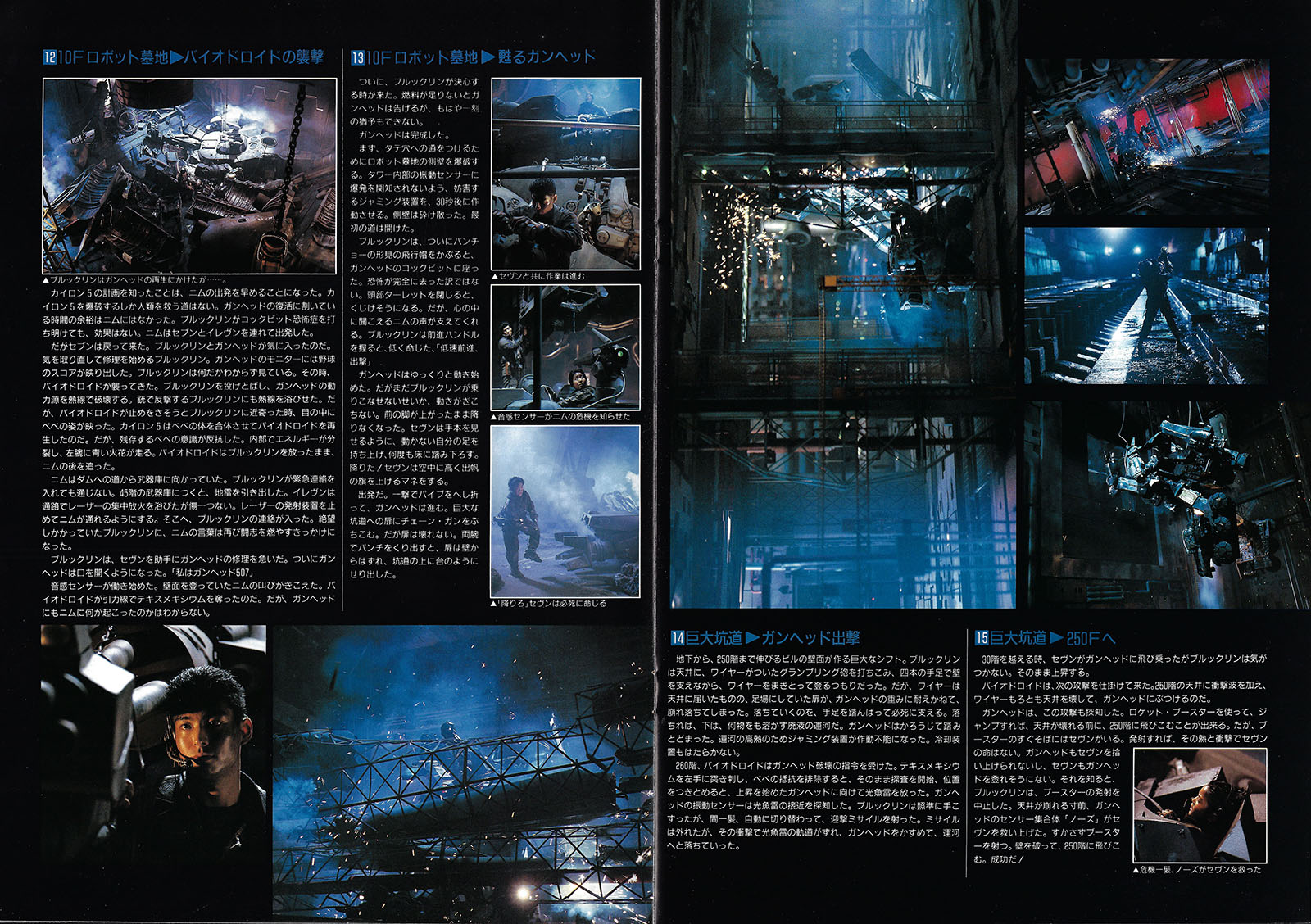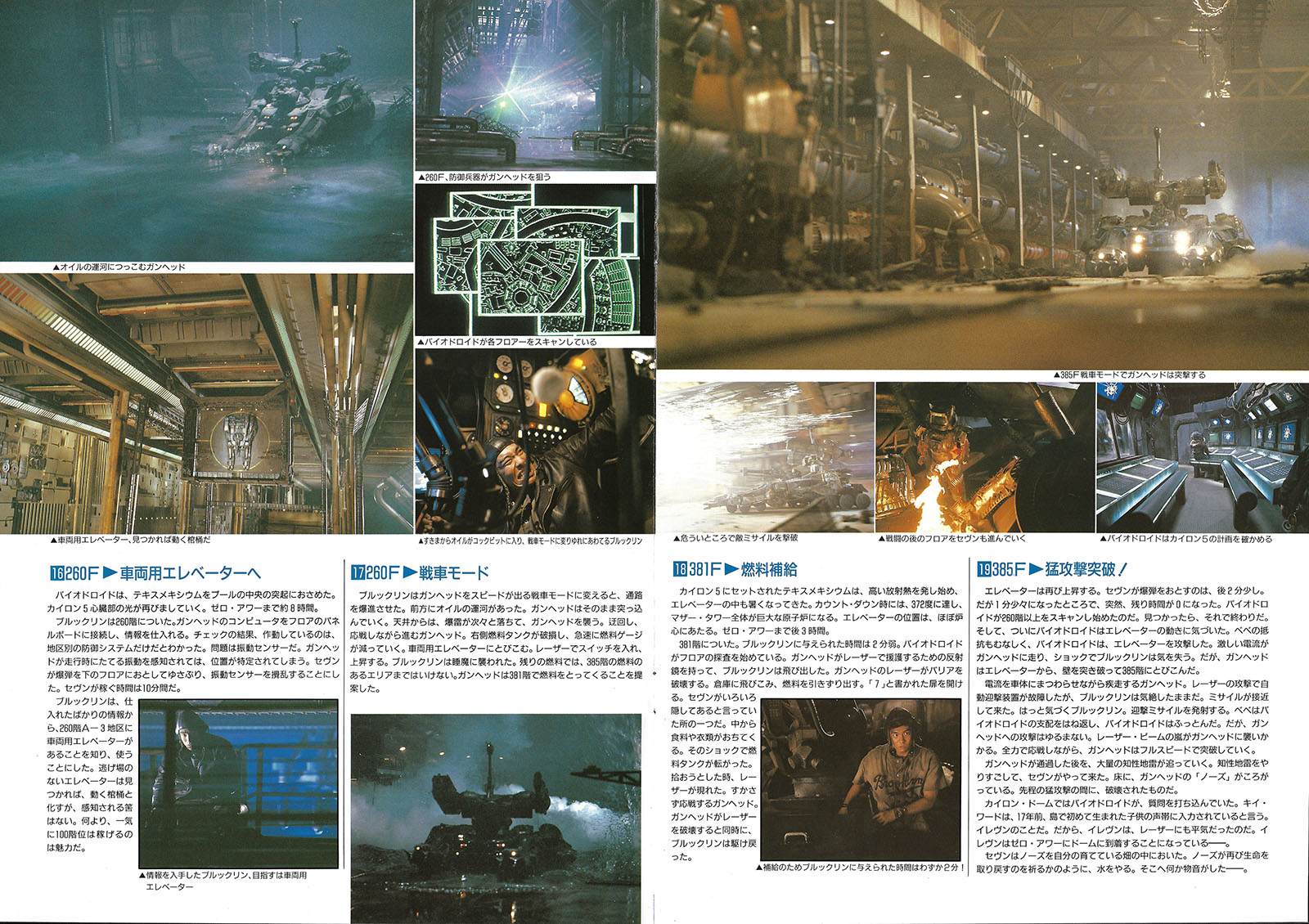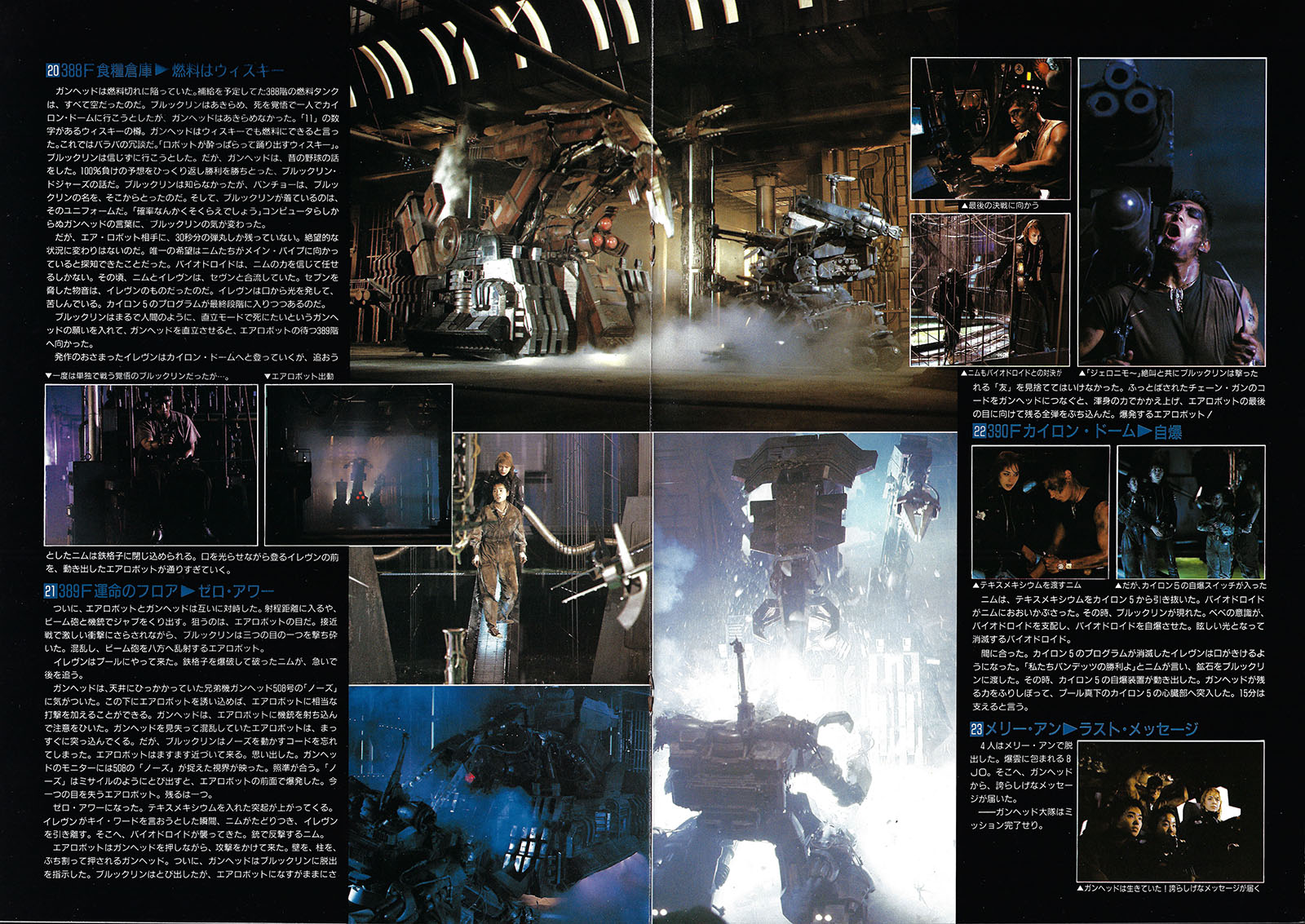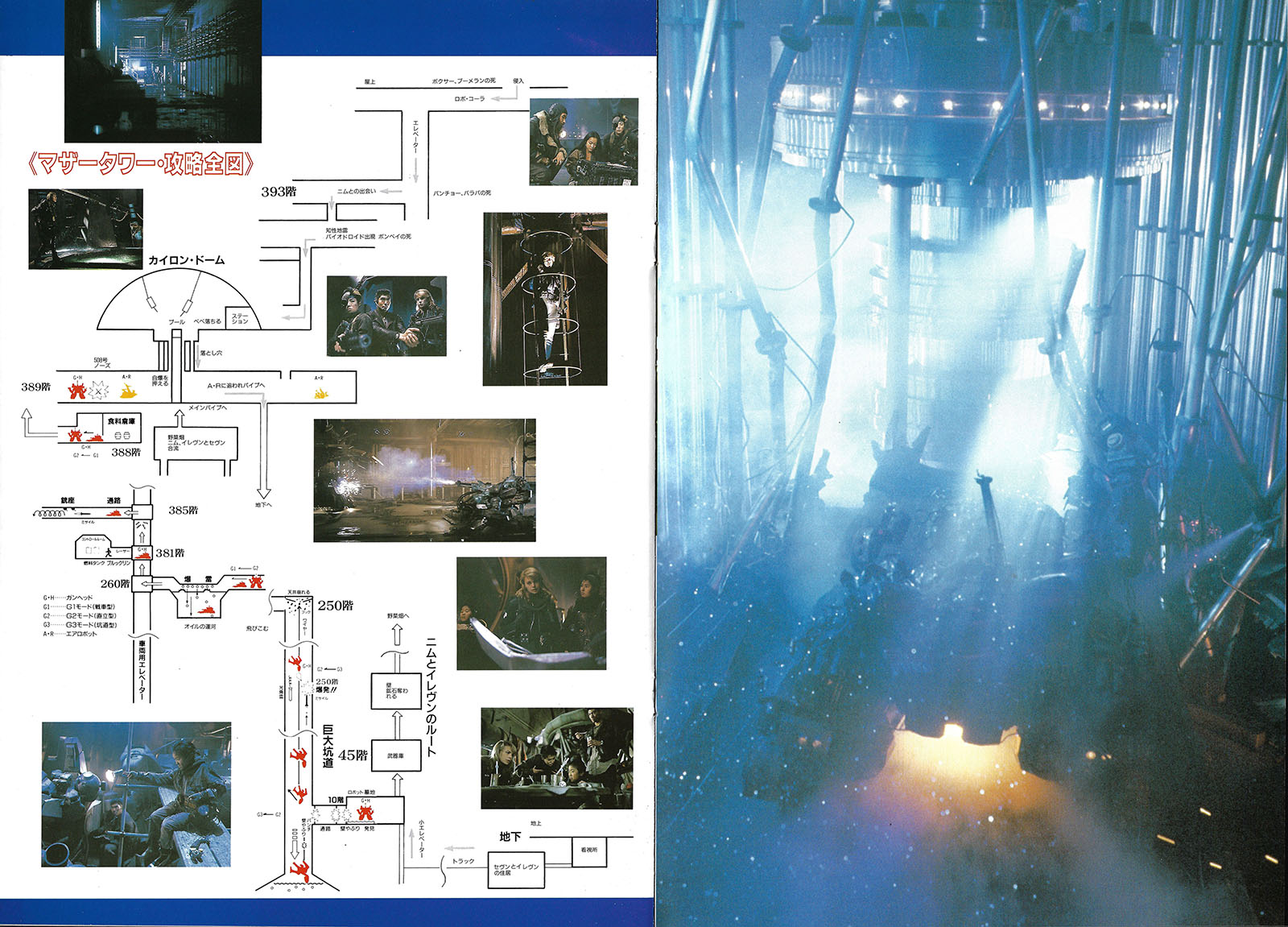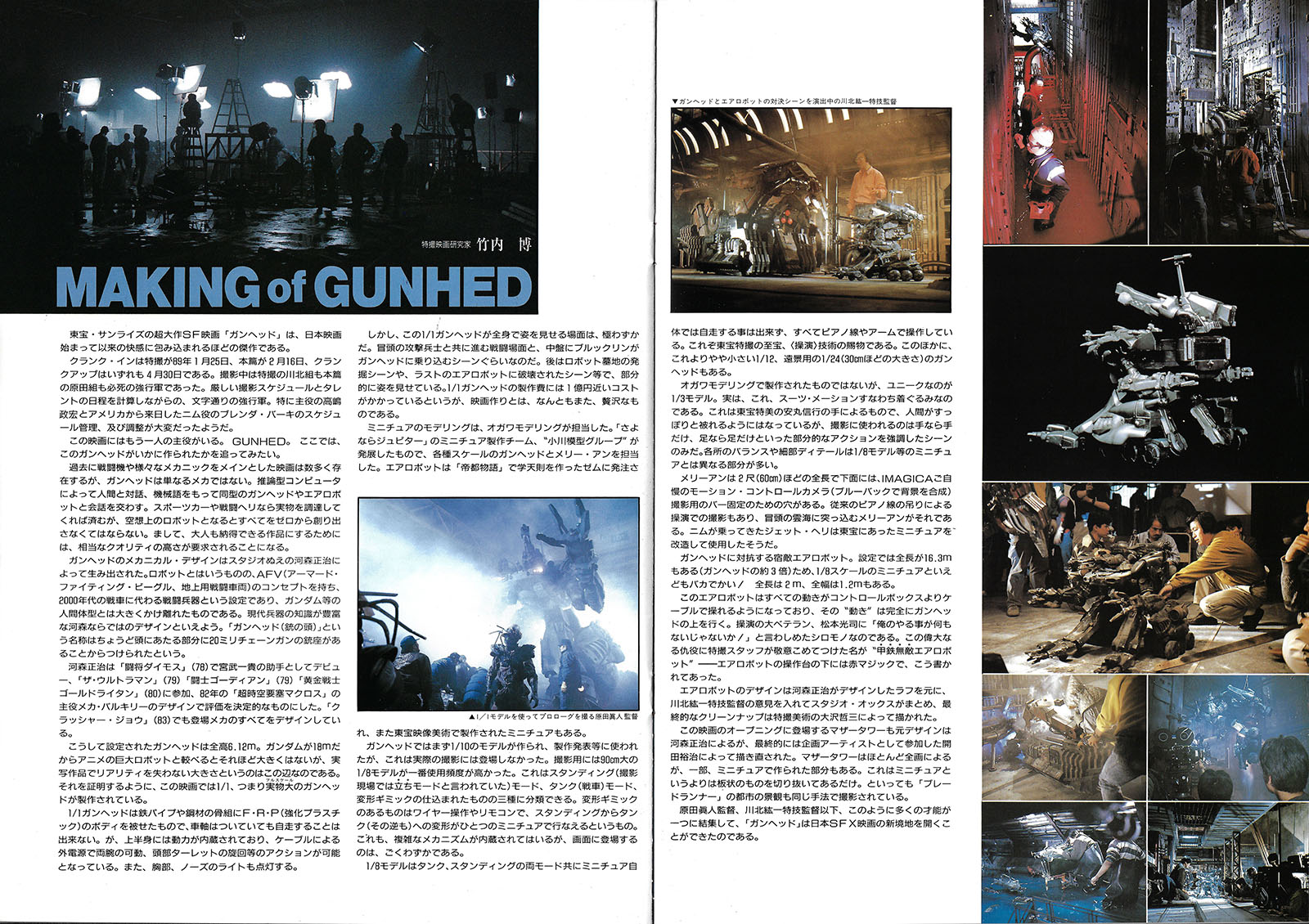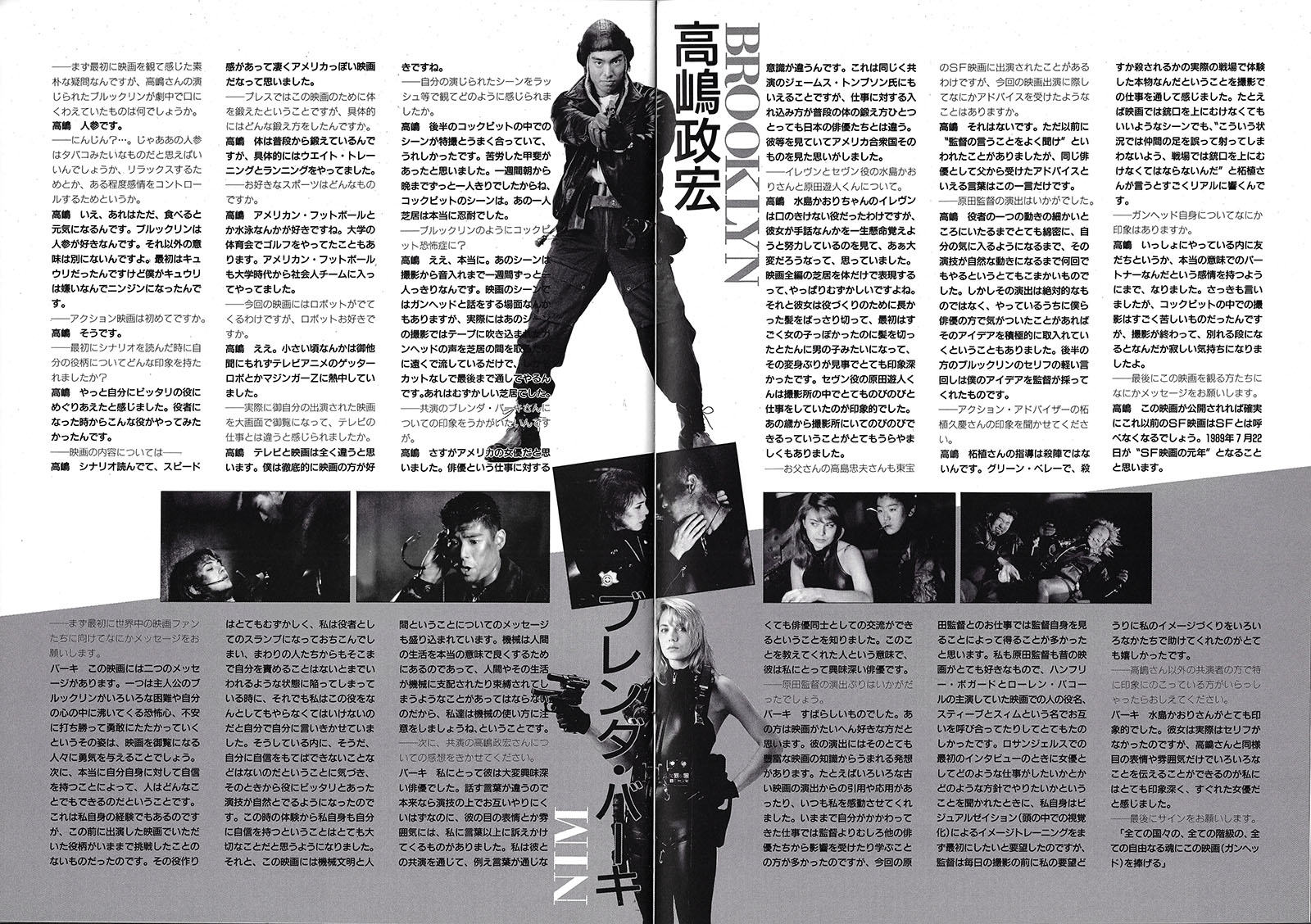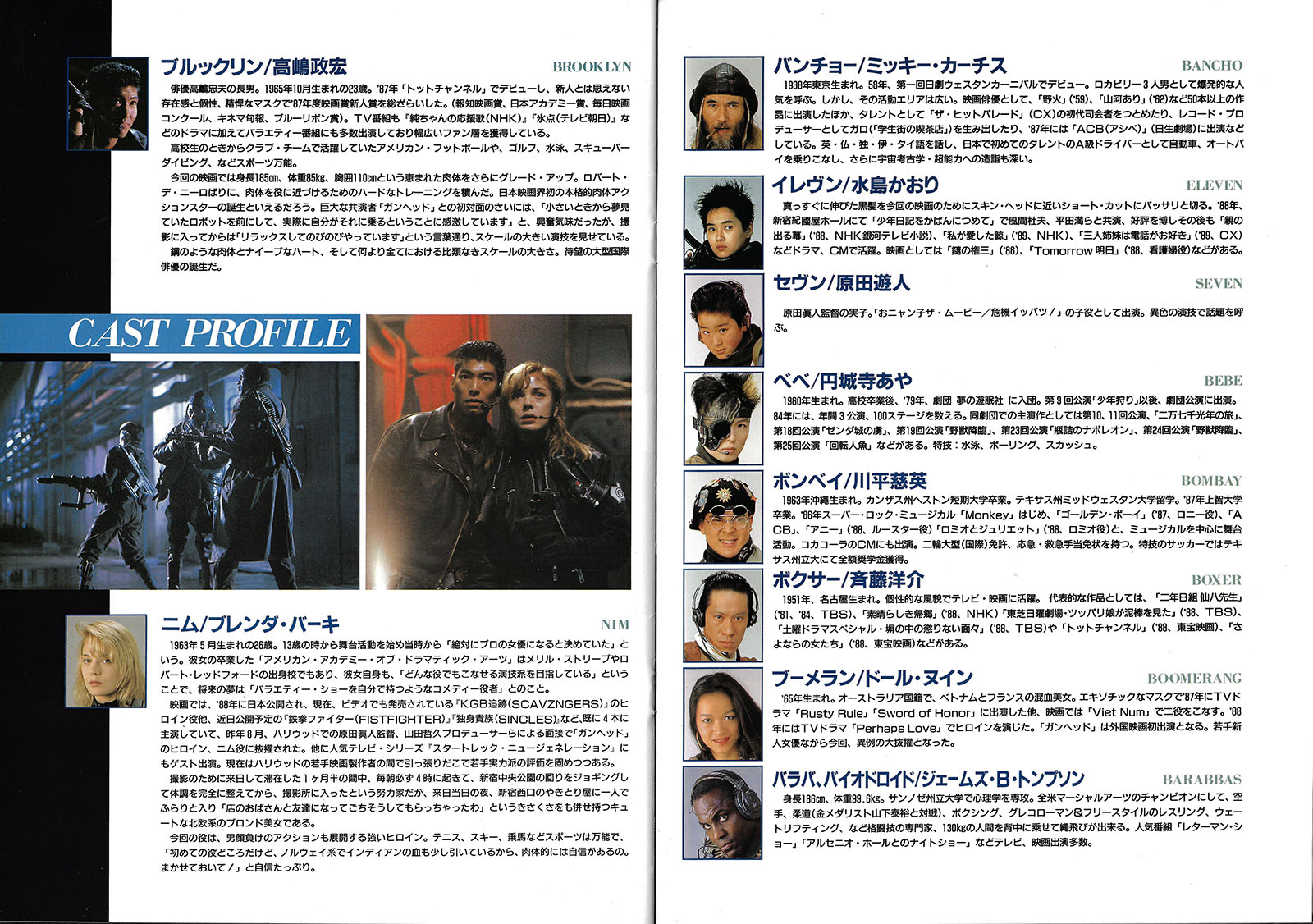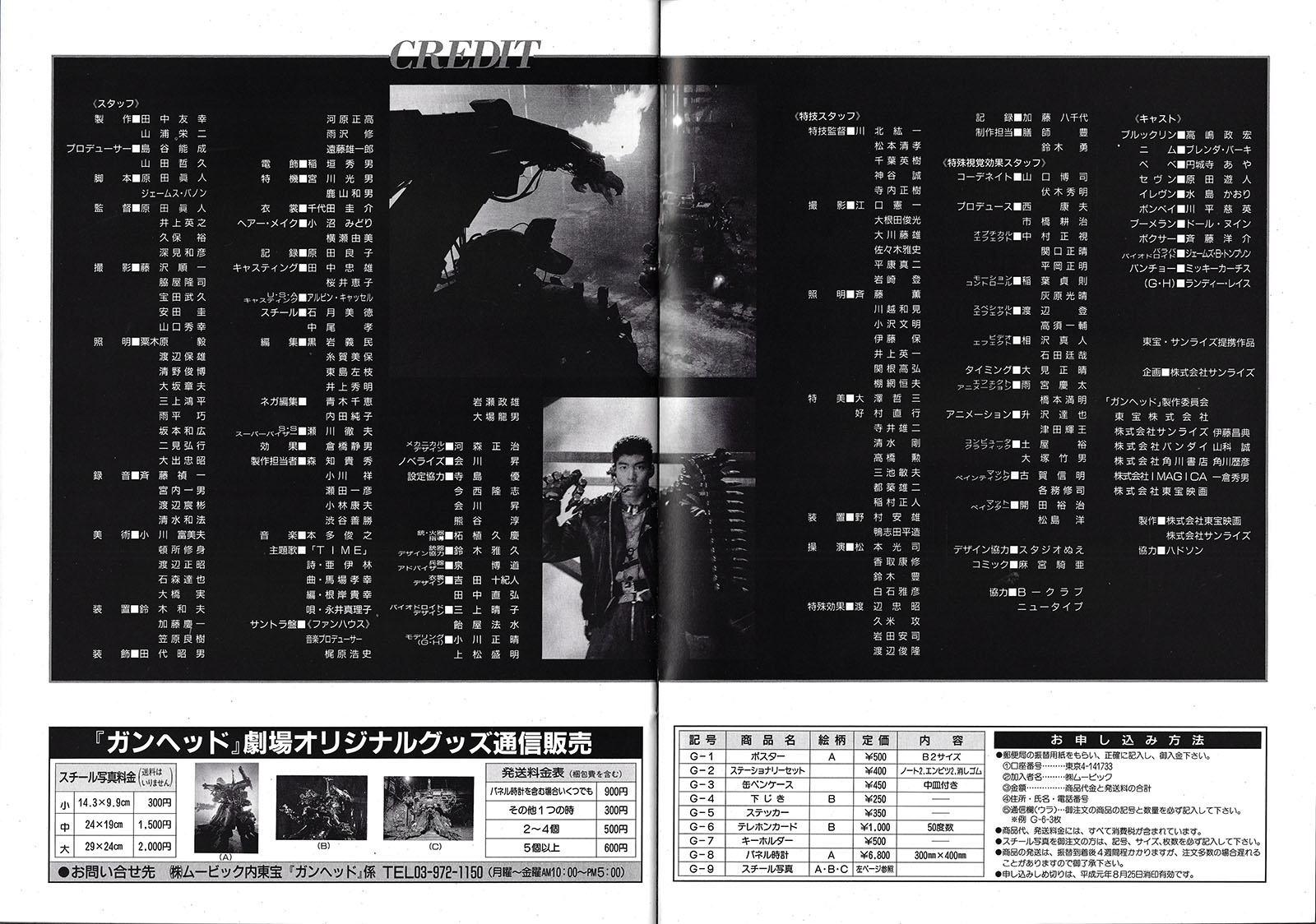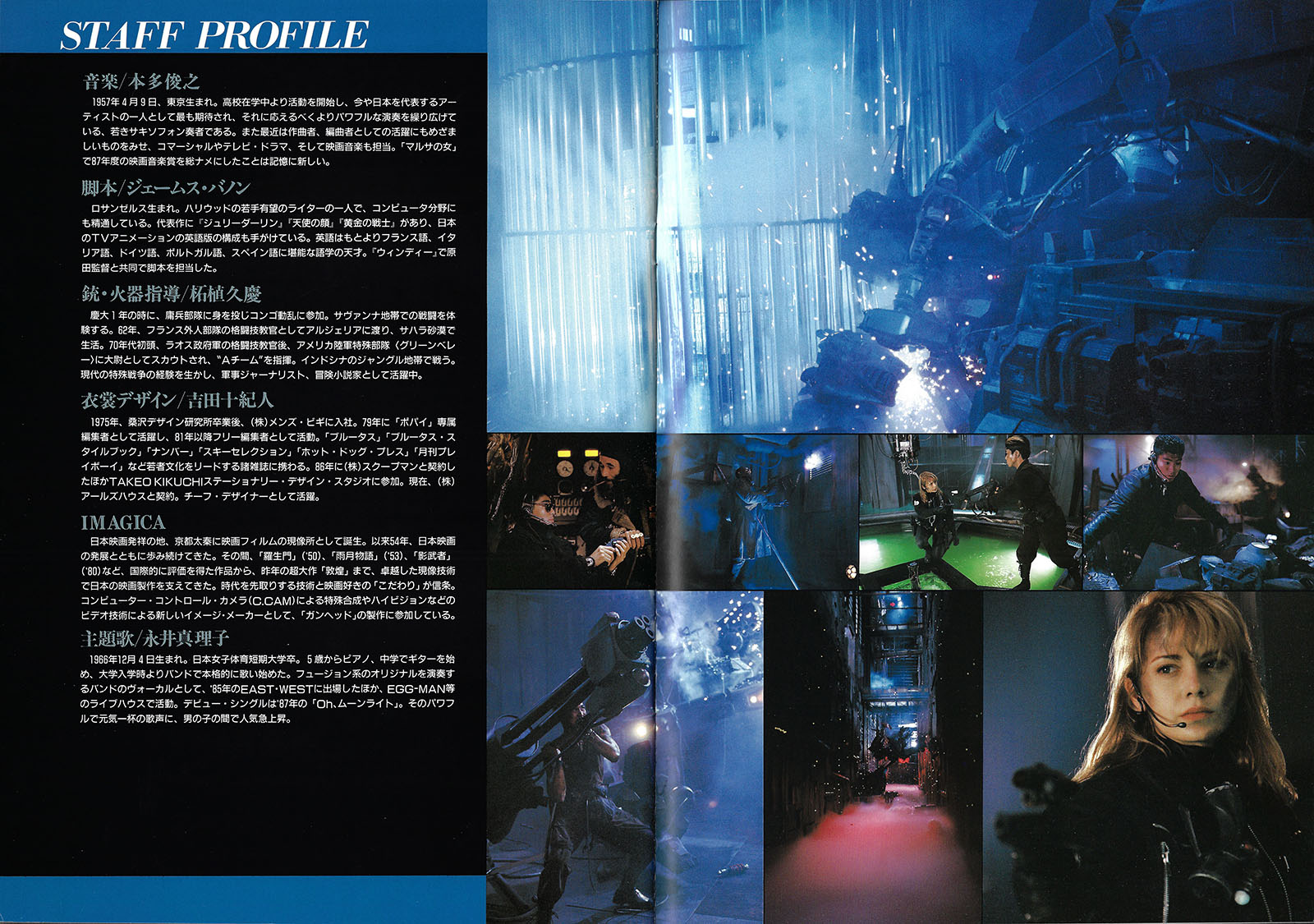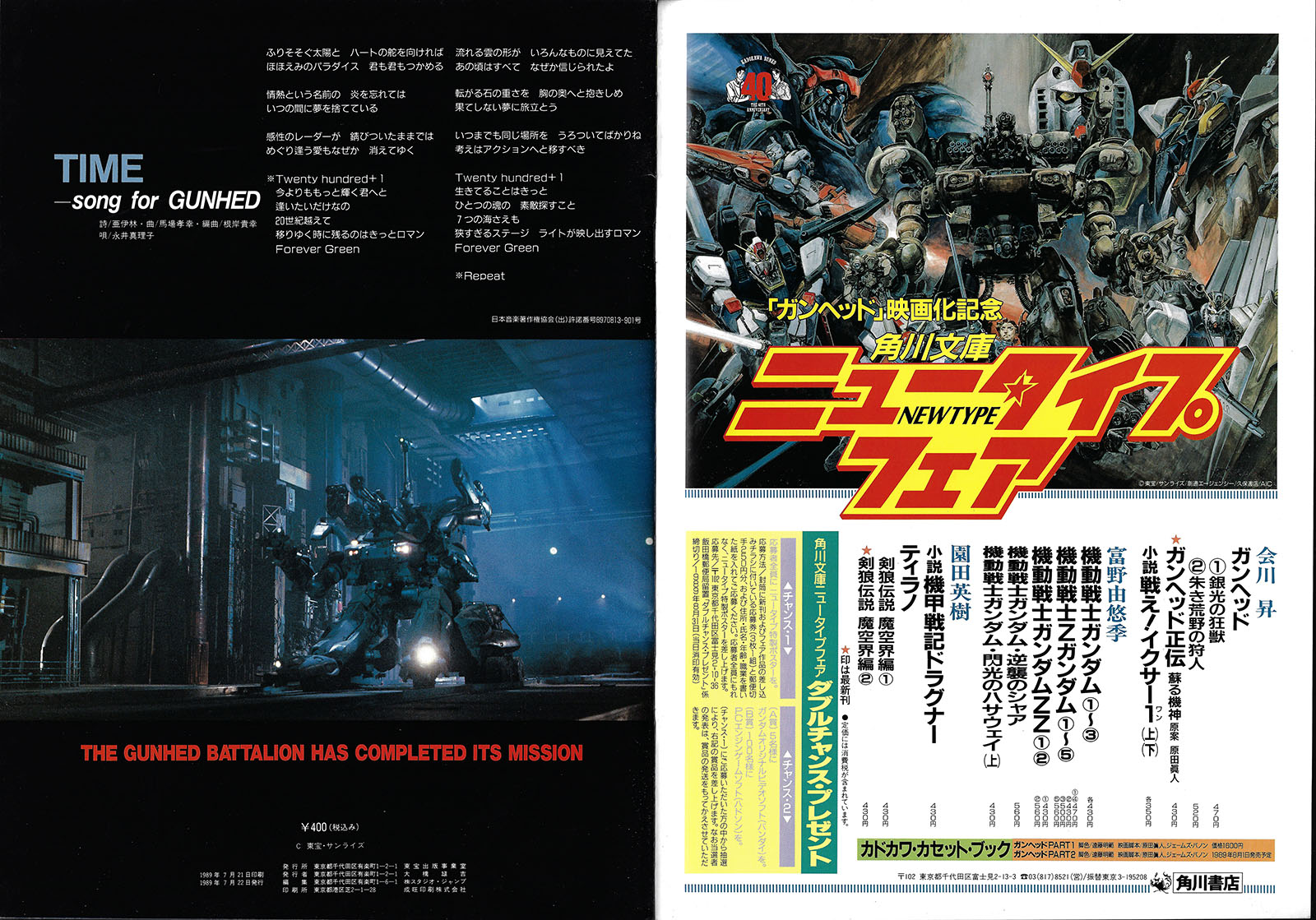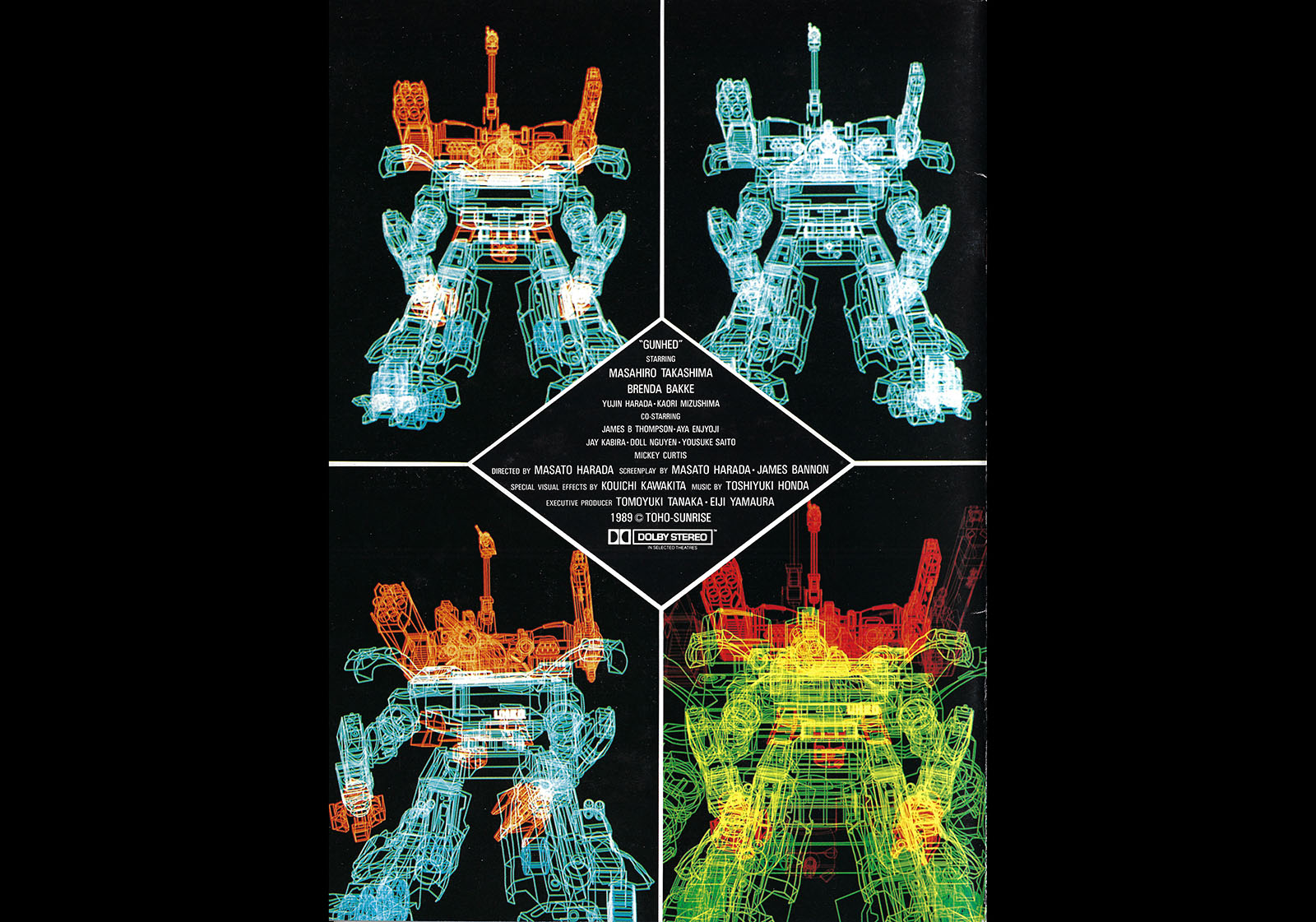Gunhed movie program book
Introduction
People are always looking for a hero. And the times have always given birth to such heroes. This work is a live action SFX film with the heavily armored mobile robot Gunhed, the ultimate in high technology, as the main character. It is an unprecedented experience, exactly what we are trying to put on the big screen before anyone else in the world.
Gunhed is an unmanned combat robot created in the first half of the 21st century. It is a huge robot with a basic weight of 38.05 tons and a field weight of 43.7 tons. It can transform from upright mode (overall length 6.12 m, height 5.28 m, maximum speed 140 km/h) to tank mode (overall length 8.7m, overall height 2.47m, maximum speed 180km/h). Each transforming joint is connected by muscle cylinders (artificial muscles) and moves smoothly, just like a human body. The robot has a built-in super high-speed computer that could be called its brain, able to assess any situation and take the most appropriate action.
The story revolves around Gunhed and a young man named Brooklyn. The year is 2039, and the location is 8JO, a volcanic island in the Pacific Ocean. The world’s first unmanned robot factory, “Mother Tower,” was built here, controlled by the giant Kyron 5 computer. Brooklyn finds himself in a tense situation in this 400-story skyscraper. He soon meets Nim, a strong and beautiful member of the Texas Air Rangers, two children named Seven and Eleven who miraculously survived on the island, and Gunhed, who lies in an underground robot graveyard.
Racing against a looming crisis, Brooklyn modifies Gunhed for manned use with the help of his three companions, and enters the cockpit himself. United with Gunhed, Brooklyn confronts Kyron 5 to the best of his ability and physical strength for the sake of his beloved friends and, above all, his own rebirth.
The director is Masato Harada, known for Windy Day, (1984) and The Heartbreak Yakuza (1987). Based on his extensive knowledge and career as a movie journalist, there is great anticipation for what his international sensibilities, honed in Hollywood for more than 10 years, will bring to the film.
The special effects director is Hiroshi Kawakita, who has created innovative images for Sayonara Jupiter (1984) and other films. Kawakita is now regarded as the inheritor of Tsuburaya Eiji’s special effects wizardry.
Shoji Kawamori, who is praised as a genius designer by science-fiction fans for his work on Super Dimension Fortress Macross, was in charge of the Gunhed design. Composer Toshiyuki Honda, who won a Japan Academy Award for his work on A Taxing Woman, (1987) is in charge of music. Hisayoshi Tsuge, a former Green Beret captain, is in charge of firearms instruction.
As for the cast, Masahiro Takashima (Brooklyn) made his debut in Tot Channel in 1987, and won the Best Newcomer Award in the same year. He trained in American football during his college years and still goes to the sports gym. He is a very Japanese man, and his physical condition is perfect for the role.
The heroine is played by Brenda Bakke, a beautiful Hollywood actress known for her roles in Scavengers (1988) and other films.
Kaori Mizushima, known for her role in A Boy’s Diary in a Bag, plays Eleven, and Yuto Harada (son of Director Harada) plays Seven.
The B Bangers are Mickey Curtis as Bancho, James B. Thompson, an all-American martial arts champion and martial arts expert, as Barabbas, and Aya Enjoji as Bebe. The cast also includes Jie Kawahira, Doll Nguyen, and Yosuke Saito.
The production team includes Sunrise, which has been constantly refining the know-how and sensibility of hero robots since Mobile Suit Gundam. The parent company Toho Pictures has produced numerous high-profile and blockbuster films. Bandai, Kadokawa Shoten, and Imagica also participate in the project.
The direct production cost was 1.5 billion yen. In addition to a life-size 1/1 model of the Gunhed, which stands over 6 meters tall, three 1/8-size models were also produced. The latest special effects processing by Imagica was used. This is a blockbuster work suitable for the first year of SFX.
Director Masato Harada
I first encountered visual science-fiction when I was 7 years old. In October 1956, NHK broadcast a half-hour science-fiction anthology called science-fiction Theater. (This title is so anachronistic that it sends a shiver down my spine just to mention it!) The following month, Superman started on KRT (now TBS, which also has an anachronistic sound!) and the stone age of visual SF began. I enjoyed these programs, but I don’t remember that I was particularly conscious of them as “science-fiction.”
For a child playing in a fantasy world, the planet Krypton was as close as the time of Suzunosuke Akado, and as far away as the streets of an as-yet-unseen foreign country. Manga was not yet divided into genres such as “science-fiction” and “swordplay.” If there were genres at all, they were classified by magazines such as Shonen, Adventure King, Gokai Book, and Shonen Gaho. I wanted to see a science-fiction movie like this!
In my fifth-grade summer, I was hospitalized for several months with kidney disease and read Jules Verne’s Mysterious Island in my hospital bed. Most children start reading Verne with Two Years’ Vacation, but in my case it was Mysterious Island. There was a world of adventure in it, more distant and unknown than in Superman, Astro Boy or Tetsujin 28. Except for the appearance of Captain Nemo and the Nautilus in the last chapter, Mysterious Island has a rather thin science-fiction flavor. But that didn’t matter. The feeling of “far away” that I had in my hospital bed was SF itself for me. (I call this SF insularity.)
Gunhed is a film that takes the two pillars of Japanese science-fiction, robot anime and Toho special effects films, and brings them to life head-on at full speed. Gunhed is a “faraway” action drama that clashes with my sci-fi sensibility, starting with Mysterious Island. It is the loudest, most Hollywood-like Japanese film in the world, dedicated to Verne, Asimov, Burroughs, Bogey and Bacall, Mary Ann, The Dodgers, Gibson, Kubrick, Lucas, Whitlock, and Hawks. It may be a spine-tingling anachronism to give Gunhed the “nationality” of a Japanese film. The enthusiasm of boys and girls born in the same year as Star Wars is the “nationality” of Gunhed.
(June 1989)
FX Director Koichi Kawakita
Movies show us the joys and sorrows of life and give us guidelines for life. They also appeal to our senses and allow us to experience the unknown. Movies can change a person’s life and sense of values. It would be wonderful if films could help us to develop our personalities and form us into noble human beings.
Gunhed is a unique film that has never been seen before. It is not only a robot from the world of manga and anime, but a real live-action visual world. Another feature of Gunhed is that its form changes from standing mode to tank mode. The best mode can be selected in response to the combat situation of the moment. The appearance of the tank equipped with a large number of weapons even has a kind of functional beauty.
The counterattack against humanity by a computer, the fruit of mankind’s wisdom and high technology, is a warning to those of us who are immersed in computer society. Not all computers are perfect. For example, we are still not immune to power outages caused by lightning, fire, information disruption, nuclear accidents, and electromagnetic destruction. In order to manage these dangers correctly and protect peace and security, we must make the final decisions and take action.
Gunhed, an unmanned combat robot, is repaired by Brooklyn (Masahiro Takashima) and converted into a manned combat robot. He overcomes his weaknesses and rides it on his own, daring to fight against the enemy Biodroid and Aerobot in order to avenge his comrades.
In this battle, there will be numerous enemy attacks. The way Brooklyn attacks and destroys them one by one and moves forward is similar to the trials of life; the fear of the invisible enemy, escaping from the enemy’s attack by a hair’s breadth, and the desperation of having to attack with little remaining ammunition. The sight of a man carrying out his objective in the extreme conditions of a final battle gives us boundless courage and fortitude.
Most important of all, we must strive toward our goals and never give up. Having a goal that constantly challenges us gives us something to live for.
This movie is not a science-fiction world. In reality, the world of land, sea, and air is becoming more and more high-tech, and robots can be used for land mine removal, or as point men performing high-risk missions such as reconnaissance. In the event of contamination from the use of nuclear, chemical, or bacteriological weapons, robots can operate unaffected by radioactivity, poison gas, or bacteria.
Countries are now competing to develop “battlefield robots.” There are invisible stealth fighters in the sky, submarines in the sea, ballistic missiles, and so on. Instead of creating weapons that will obliterate the human race, we need to develop robots that can be used for our prosperity, to build a peaceful and ideal world.
I hope that this film will inspire you to strive toward your goals with lessons of “calm, composure, courage, and action.” I will be happy if you feel something from this film.
(June 1989)
Gunhed Prehistory
At the beginning of the 21st century, humanity was facing a turning point.
The depletion of Earth’s resources, which had continued since the 20th century, reached a critical point. The tightly knit economic systems of each country had become so deeply entangled that the failure of a single country could lead directly to global ruin.
This, combined with the deployment of laser beam weapons and the disabling of the nuclear strategy system, led to the formation of a World Federation for the first time in human history. The primary function of the federal government was, above all, the fair and efficient distribution of resources. To this end, the “Titan,” a connected system of seven supercomputers, was the real management. The capital city was Dallas, USA.
The federal government adopted a policy of designating residential zones and concentrating people there as the global population continued to decline. However, there was strong opposition to the designation of residential zones, as well as cities being converted to “domed prisons.” Local wars broke out in various areas. The federal government responded with military force. On the other hand, the shortage of labor due to the decrease in population led to the rapid development of the robotics industry. The use of robots, which had developed by leaps and bounds, increased dramatically.
In 2005, Cybortech Corporation, a company under the direct control of the federal government, built a fully-automated robot manufacturing plant on the volcanic island of 8JO in the Pacific Ocean. The management and operation of the plant was entrusted to the newest and most powerful advanced computer, the Kyron 5. It had a self-programming function that allowed robots to be improved without human intervention. The island needed no humans except for a few engineers, and robots made on 8JO were sent out into the world.
The next 20 years passed uneventfully. But in 2025, Kyron 5 suddenly declared war on mankind. Missile and laser attacks failed at every turn in the face of Kyron 5’s powerful defenses. The federal government finally decided to deploy the Gunhed Battalion, and the robot war began. Because Gunheds were developed by human hands, Kyron 5 was forced to fight an uphill battle. But it was able to break into the Titan lines, obtain the data, and also succeeded in disrupting the information stream. Gunhed battalions were defeated one by one.
On the 373rd day of the battle, the last Gunhed was closing in on the Kyron 5 control center on the 389th floor of Mother Tower. An Aerobot’s attack halted its charge. With the annihilation of the last Gunhed battalion, the human race lost the means to attack Kyron 5. But fsome reason, Kyron 5 ceased its activities and the island went silent. The federal government had no choice but to designate 8JO as a contaminated area and continue the blockade and surveillance…
Visit the art gallery page for a larger version of the “action map” shown above.
The Making of Gunhed
By Special Effects Researcher Hiroshi Takeuchi
Toho and Sunrise’s blockbuster science-fiction film Gunhed is a masterpiece that envelops you in the pleasure of seeing a first in Japanese cinema.
Crank-in (start of production) was on January 25, 1989 for special effects, February 16 for the main story, and April 30 for crank-up (wrap of production). Both the Kawakita team for the special effects and the Harada team for the main story were on a desperate forced march while calculating the tough shoot and the actors’ schedule. Managing and coordinating their schedules was very difficult, especially for Masahiro Takashima, who played the lead role, and Brenda Bakke, who came from America to Japan to play Nim.
There is another main character in this film, Gunhed. Here, I would like to trace how the Gunhed was created.
While there have been many films in the past that have featured fighter planes and various mecha as main characters, Gunhed is not just a mecha. It uses a reasoning computer to interact with humans and speaks in machine language with other Gunheds and Aerobots. If you need a sports car or a combat helicopter, it is enough to procure the real thing, but if it is an imaginary robot, it has to be created from scratch. And to make a work that satisfies even adults, it must be of a very high quality.
Gunhed’s mechanical design was created by Shoji Kawamori of Studio Nue. Although it is a robot, it has the concept of an AFV (Armored Fighting Vehicle), a combat weapon to replace the tanks in the 2000s. It is a far cry from the humanoid form of Gundam and other such mecha. The design is unique to Kawamori, who has extensive knowledge of modern weapons. The name “Gunhed” (gun head) is said to be derived from the 20mm chain gun turret located at the top of the head.
Shoji Kawamori made his debut as an assistant to Kazutaka Miyatake on Daimos (1978), and then worked on The Ultraman (79), Gordian the Fighter (79), and Gold Lightan the Golden Warrior (8O). His reputation was sealed with the design of mecha Valkyrie, the main character in Super Dimension Fortress Macross in 1982. He also designed all of the mecha in Crusher Joe (83).
Gunhed is 6.12m tall, not so big compared to the giant robots of anime like Gundam (18m), but it is a big robot that does not lose any reality in live-action. As if to prove this, a life-size 1/1 Gunhed was produced for this film. The 1/1 Gunhed has an iron pipe and steel skeleton framework, covered with an FRP (reinforced plastic) body.
Even though it has axles, it cannot run on its own. However, the upper body has built-in power, and external power source via cable allows the arms to move and the head turret to turn. The head turret can be swiveled and other actions are possible. The lights on the chest and nose light up.
However, there are only a few scenes in which this 1/1 Gunhed shows its whole body. In the beginning of the film, there is a battle scene in which the Gunhed advances with attacking soldiers. In the middle of the film, there is a scene where Brooklyn gets into the Gunhed. The rest of the shots are the excavation scene in the robot cemetery and the last scene in which Gunhed is destroyed by the Aerobot. The production cost of the 1/1 Gunhed is said to be close to 1,000,000 yen ($10,000), a very extravagant cost for making a movie.
Ogawa Model Group, the miniature production team on Sayonara Jupiter (Toho, 1984) was in charge of miniature models, such as Gunhed and Mary Ann in various scales. The Aerobot was built by Zem, which produced Gakutensoku for Teito Monogatari (Toho, 1988) and other miniatures were produced by Toho Visual Arts.
A 1/10 Gunhed model was used for production announcements, but did not appear in the actual filming. The most frequently used model for filming was a trio of 1/8 models, 90cm in size. One was in standing mode and another was in a tank mode, operated either by wire or remote control. The third could transform from standing to tank mode (and vice versa) as a single miniature. Each of them has a complex mechanism built in, but only a few of them appear on the screen.
The 1/8 model cannot run by itself in either tank or standing modes, and was controlled by piano wires and by hand. This is a treasure of Toho’s tokusatsu (special effects) production, and is the result of their “manipulation” techniques. There was also a slightly smaller 1/12th scale Gunhed and a l/24th scale version (about 30cm in size) for distant views.
Yet another model was in a unique 1/3 scale and was not built by Ogawa. In fact, this was a suit-mation version, or a costume made by Nobuyuki Yasumaru of Toho Special Effects. Although it was designed to be worn completely by a human being, it was used for filming individual parts, such as hands or feet. The balance and details of each piece was different from those of miniatures such as 1/8 models.
Mary Ann is about 2 feet (60cm) long, and had an opening to affix a bar when shooting (against a bluescreen backdrop) with a motion control camera, the pride of Imagica. Some shots were taken using traditional piano wire suspension, such as Mary Ann‘s plunge into the sea of clouds at the beginning. The jet heli that Nim flew was a Toho miniature modified for the film.
According to the specs, the Aerobot is 16.3m long (about 3 times as long as the Gunhed). Even though it was a 1/8 scale miniature, it was still ridiculously large; its overall length was 2 meters, and its width was 1.2 meters. All movements of this Aerobot can be controlled by a cable and its “movement” is completely beyond that of the Gunhed. Koji Matsumoto, the veteran operator of the Aerobot, said, “There’s nothing for me to do!” Out of respect, the effects staff gave this great enemy the name “Invincible Aerobot,” written under the robot’s control panel in red marker.
Aerobot was based on the rough design by Shoji Kawamori. Studio Ox simplified it with input from special effects director Koichi Kawakita, and the final cleanup was drawn by artist Tetsuzo Osawa.
The Mother Tower that appears at the opening of the film was originally designed by Shoji Kawamori but was redrawn by Yuji Kaida, who participated in the project as a planning artist. Mother tower is primarily a painting, more of a cutout plate, but some parts were made in miniature. The urban landscape in Blade Runner was shot using the same technique.
Director Masato Harada, Special Effects Director Koichi Kawakita, and many others came together in this way to create Gunhed and break new ground in Japanese SFX cinema.

